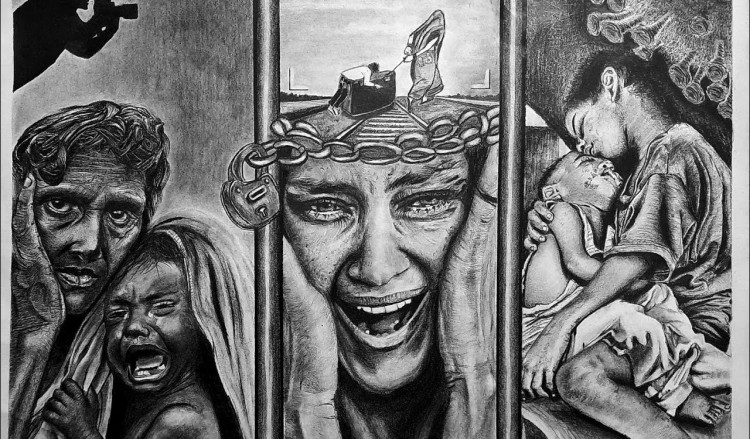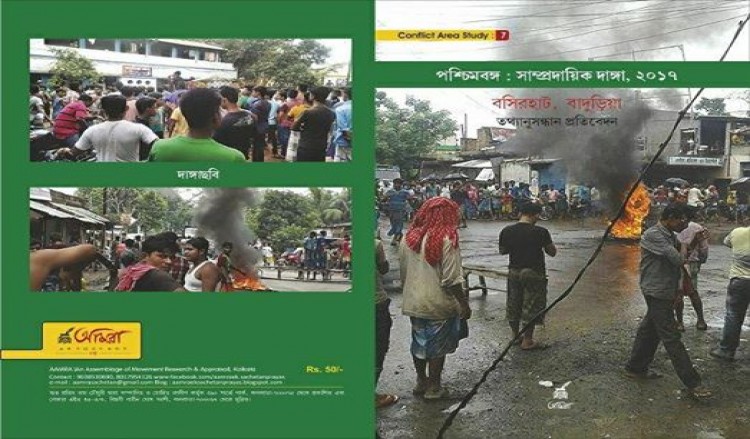
Rejinagar Shariyati Violence
In contemporary Bengal, one of the most important trends is to strategize for converting a multicultural society to a monolithic pattern. The incident of Rejinagar Shariyati violence is a continued and well-planned strategy of Political Islam to destroy and occupy Sufi centers. The philosophy of single brand always attacks multiculturalism in different religiosity. The rise of Hindutva forces doing the same in different parts of India by imposing single brand of faith.
Rejinagar Shariyati Violence
A Fact-Finding Report
First Published: 15 August, 2017
Fact-Finding Team Members-
Akbar Ali Sekh
Suman Nath
Subha Protim Roy Chowdhury
Amitava Sen Gupta
Faruq Ul Islam
Written by- Suman Nath
Edited by- Subha Protim Roy Chowdhury
Published by
Anupam Das Adhikary
Disclaimer
All the names used in this report are real names. The name and other identity of the Imam are not disclosed as per his request. The participants in this fact finding exercise have expressed their willingness to be quoted their narratives with their names. Since, most of them are victims; they want their pain to be shared by the wider audience along with their identities. Therefore, keeping in view of their demand, we believe that using fake name here to conceal their identity, which is otherwise a standard practice in social science research is not needed here.
On behalf of AAMRA we also declare that the report is prepared by using standard method of doing social science research which includes Focus Group Discussion, Semi Structured Interview, audio visual recording and document analysis. The findings are therefore should be treated as an outcome of rigorous social science research and practices. Any usage except for some reference usage for research purpose with proper referencing is strictly prohibited.
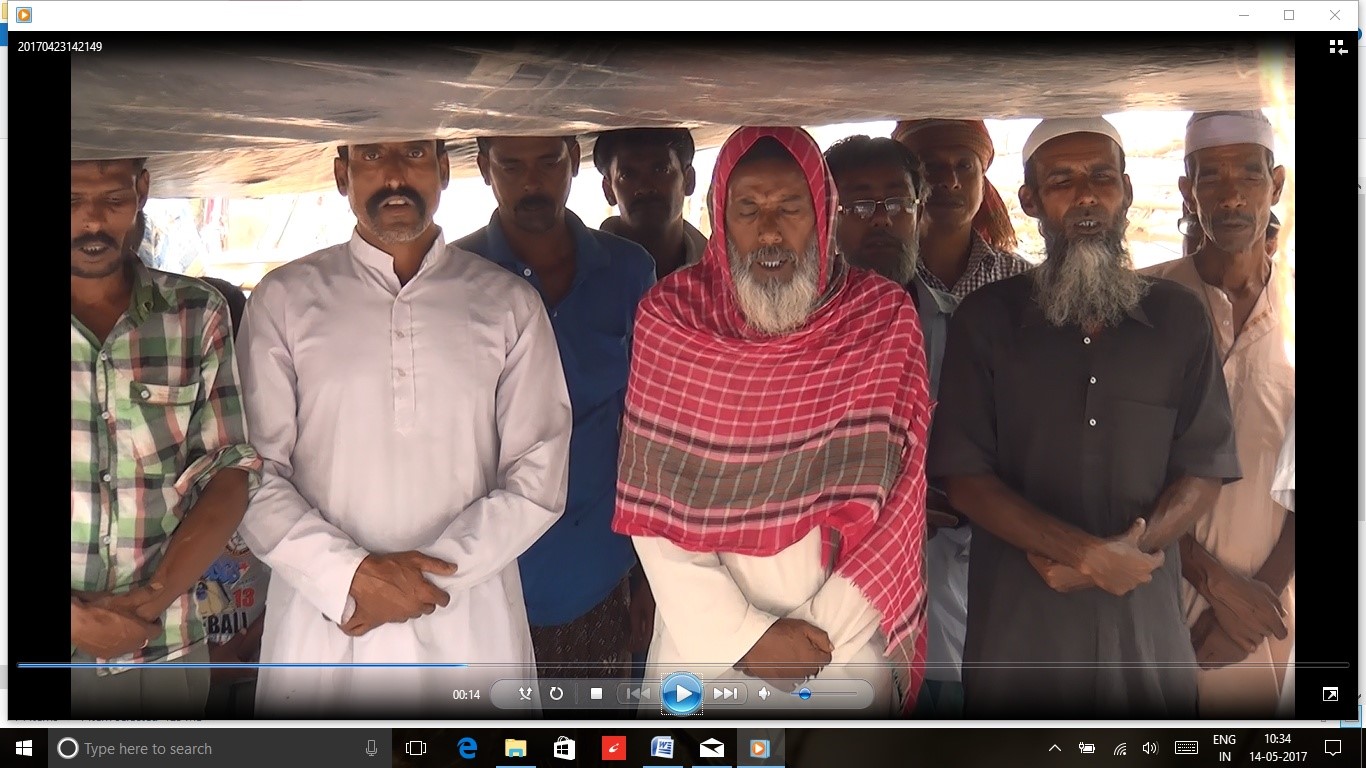 Initiation of Ursh, 23rd April, 2017. Person in middle Sudon Mollah.
Initiation of Ursh, 23rd April, 2017. Person in middle Sudon Mollah.
Prelude
“Out beyond the ideas of wrong doing and right doing, there is a field — I’ll meet you there.”
— Jalaluddin Rumi
One of the most important trends in contemporary Bengal is to strategize for converting a multicultural society to a monolithic pattern. The century long tendency of attack on Bengalee folk singers, Baul-Fakirs on the name of societal chastity now turns in to more perilous position. Political religion in structured and localized form now targets parallel system of belief and practice in own religion. And here Rejinagar incident provides us a chronicle of torture in such a symmetrical pattern that we decide to publish it in separate book head as the topic requires more concentration for its exclusivity among other contemporary discourses. Giving voice to the shared perception of all the tortured folks, we also target to publish separate report on attacks against Baul-fakirs very shortly.
Orthodoxy in both sides seeks to perpetuate on illusionary dichotomy they used, which juxtapose a highly charged, religio-politicized Muslim identity. We know that Salafism or Wahabism1 (referred as a cult of Ahl-e-Hadith) is supposed to be directly opposed the Sufi tone of Islam. Here in India due to democratic and secular polity conflict was not aggravated or took a violent appearance. Apart from the stanch followers of Shariyati and Sufism (here villagers called them as Pirponthi); it is totally confusing for the common Muslims to identify their differences and why they condemn and criticize each other.
Drawing on inclusive narratives and interactions with the survivors of the Rejinagar Shariyati violence, common people and activists who resisted; this report anatomizes how Radical Islam hypothesizes to engulf Popular Islam or Sufism. This meticulous field study makes a significant and timely contribution to the discussions on radicalization of society, administrative inaction and particularly peoples resistance. It is a little but in-depth research we able to complete.
We visited the villages, Teghori, Paschim Teghori and Nazirpur (under Rejinagar Police Station, Murshidabad) three times; the second one was the time of Ursh, the place where Shariyati mob ransacked a Darbar, a bamboo made local construction. Despite the anti-Pirponthi stand of local Imams a sizeable crowd participated there and also rituals were performed. While in our rudimentary visit, we were experienced by the stricture of the female members of the family of the respondent Khadims, particularly in the area where Shariyati mob ravaged Sufi Centers. The village, Paschim Teghori, where Pirponthis resisted and able to prevent destruction of their Darbar, was much more spontaneous. In the area of rest three Darbars, which were ransacked in a same day (29.10.2016) people remain unspoken. We also visited an old Darbar, Shariyati mob destroyed it 7 years back, and here victims shared that incident with grief and grievance. We keep all interactions and anguishes verbatim.
We are informed that Piponthis are threatened after our departure as they dare to reveal the atrocities they got from Shariyatis. The Pirponthis of Paschim Teghori, the resisting force here play the lead role to organize followers of different Sufi Tariqas2. Here two major Tariqas of Indian sub-continent, Qadiriya3 and Chishtiya4 have their followers.
Their mystical approach, religious performance in front of grave, use of music, musical instrument and dance create irksome for Shariyati followers. Shariyati followers believed that these cultural activities are against Islam. They announced restriction or publicized Fatwa by banning Mazar, Dargah, Nazargah, Darbar, Akhra and Ursh; if anybody (Muslim) goes there and takes part in the religio-cultural activities will be boycotted and also terminated from Islam. The said villages in Rejinagar witnessed the brutal materialization of Fatwa.
Our attempt to make contact with the Imams of local Mosques (including Jame Masjid) failed initially. But by the condition to keep his identity secret, an Imam emphasized their stand quoting Hadith and also denied his personal involvement in 29th October incident. The practice of Different Sufi orders in this village is Shirk, he said. In Islam the Shirk means the sin of practicing idolatry or Polytheism. The Hadith he talked about were mentioned in this report.
We repeatedly make attempt to talk with the Rejinagar Police Station, but we became unsuccessful. On 11 May, 2017 we emailed to the District Magistrate of Murshidabad and the Block Development Officer of Beldanga-II Block urging restoration of peace and normalcy and to book the perpetrators of Darbar destruction under the relevant section of Indian Penal Code. But till date no reply came in. No person was arrested.
We think the incident of Rejinagar Shariyati violence is a continued and well-planned strategy of Political Islam to destroy and occupy Sufi centers. The philosophy of single brand always attacks multiculturalism in different religiosity. The rise of Hindutva forces doing the same in different parts of India by imposing single brand of faith. In West Bengal, the hobnobbing between ruling party and Imams, Clerics gave a clear message to the mass that who are the authority of Muslim community. The unconstitutional powers they possess are largely hypothecated by the ruling party and these gave the massage to the administration to remain dysfunctional.
The Rejinagar-pattern atrocities were already in motion in various parts of West Bengal; it is our inability that we are unable to make documentation for every incident. We know about the brutal attack on Lal Shahbaz Qalandar Sufi Shrine at Sindh, Pakistan on February, this year. The blast took place during a Sufi ritual, Dhamal, when thousands of devotees were present. 85 persons were killed. People reacted largely, protested by performing Dhamal. Disgracefully here the day is nearer.
Subha Protim Roy Chowdhury
For AAMRA
Attack on Pirpanthis or Sufis in Rejinagar
Recently in West Bengal we are witnessing a resurgence of religious sentiments in everyday discourse, even within personal and intimate conversations. As is well known Indian subcontinent represents at least two major Muslim lifeways, viz. the Shariatis, the one who takes Quran as the supreme entity and the Pirpanthis or Sufis who follow fragments of different traditions channelized often by localised teachers or gurus known as the Pirs. This fact finding report focus on a conflict between the two in Rejinagar, Murshidabad. It appears that until recent past the two traditions were not polarised. There were no incidents of intolerance to each other until recently. Pirpanthis could go to the local Mosques, practice their Namaz and yet could engaged in Pirpanth or Sufi practices which include participation in music, dance, organising Ursh, discussing religious faith with people from other religious background. In fact the Fact-Finding team have found the Pirpanthis saying typical Hindu way of greeting a fellow disciple “Jay Guru” instead of “Wasalam-Waliqum” – which is otherwise familiar Muslim way greeting each other.
However on 29th of October 2016 there was an incident of attacks on Pirpanthis by the Shariatis resulting in organised demolition of three Darbars (also called as Khanqah Sharif1) within the village on a single day. It is expected that victims and their families have been traumatised. The news coverage from leading news paper on this incident was not visible, except some narrow back page coverage in District level supplementary of two news papers. Electronic media didn’t care for the distressed Sufi supporters. AAMRA was working in some limited localities on attack against Baul-Fakirs in West Bengal and Bangladesh. We got the information through our personal network and made plans to make visit and collect the facts. However, because of the curfew and heated situation within the villages, AAMRA decided to give it some time so that their intervention doesn’t create additional trouble in the village life. In April 2017, about little more than four months after the incidents two teams from AAMRA and Akbar Ali Sekh on behalf of Baul Fakir Sangha (a forum for folk singers) tried to interact with the different layer of the villagers on what happened at the villages of Reginagar. How did it happen? Why did it happen? And what is the social impact?
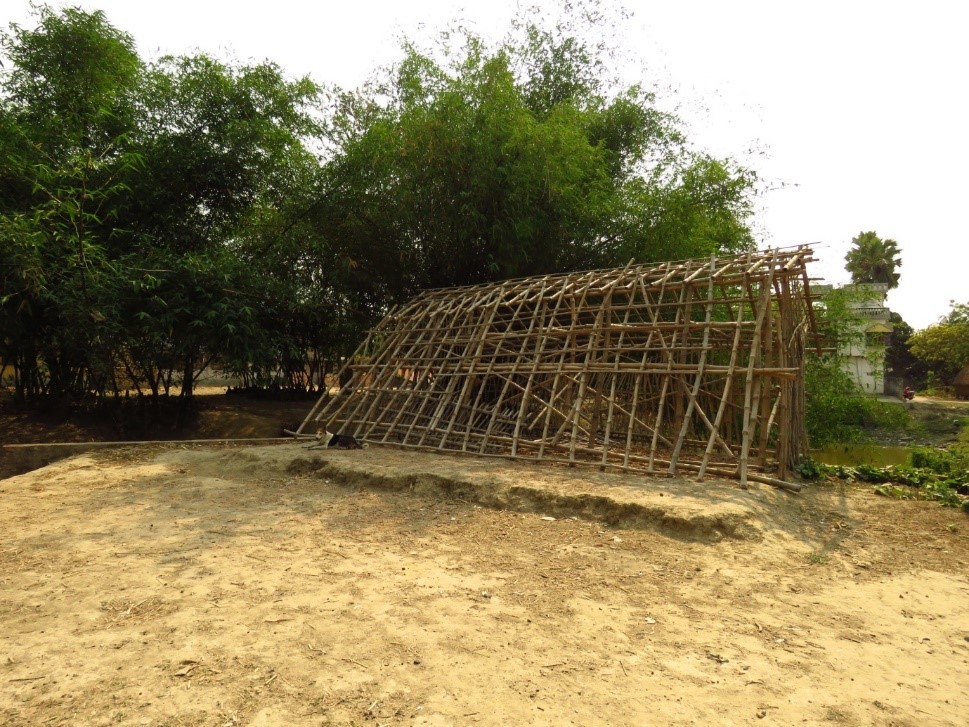
The vandalised Khanqa Sharif as we saw in first week of April 2017
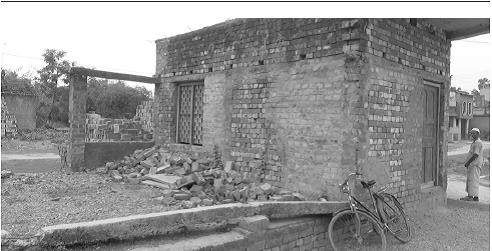 A vandalised local religious establishment...
A vandalised local religious establishment...
The context of experience
With a population of about 17,000 Teghori, Paschim Teghori and Nazirpur are three villages located at the South-Eastern side of the Reginagar Railway station. These villages come under the Andulberia II Gram Panchayat, Beldanga II Panchayat Samiti of Murshidabad District, West Bengal. The area comes under Rejinagar Assembly Constituency. The Member of Legislative Assembly at present belongs to the Trinamool Congress (TMC), the ruling party of the state. These villages have only about ten families of Hindu population and the rest are Muslims. There used to be only one old mosque in the region during early 80s. With increase in population at present there are about eight mosques located at different places within these three villages. Interestingly there is a substantive development of number of mosques in recent past especially after 2010. Whether there is any significance attached to the year 2010 is nevertheless difficult determine. A Government sponsored School (GS); a few unregistered Madrasas and villagers’ willingness to send their children to Government sponsored School roughly indicates a so called ‘progressive’ ambiance within the village. The general attitude of Muslim populace in the district is preference to Government School at first and Madrasa, a lesser option if GS is in distant location. Moreover there is no shortage of number of white collar professionals (several school teachers, two doctors and few engineers) who begin their study from within the village. One of the villagers proudly reports that this year one of the village boys have cracked Medical Entrance Examination and once he completes his studies this village is going to have three physicians soon.
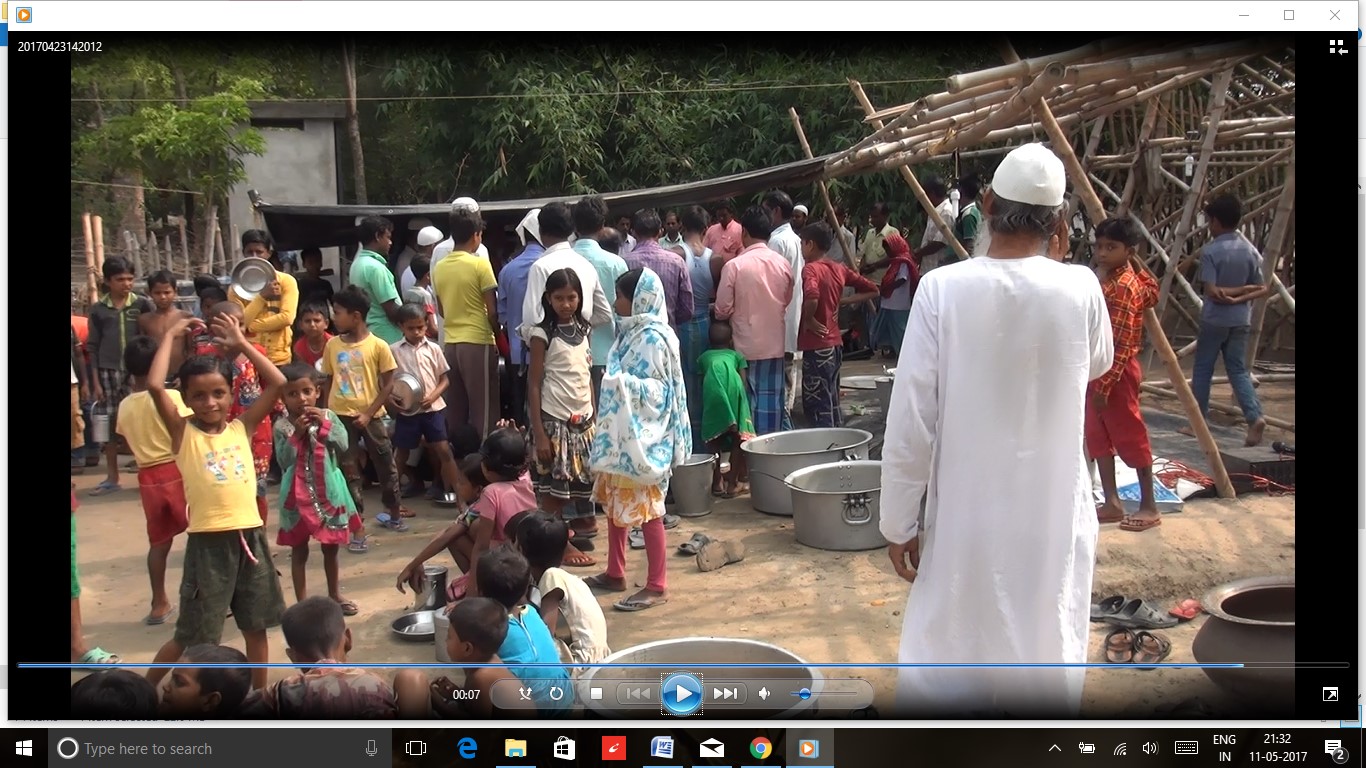
Ursh festival being organised at the vandalised Khanqua Sharif, of Chistia tariqa on April 23, 2017
The main road which connects Rejinagar station with the villages is metalled and in good shape. However, roads within the villages are a mix of half-done concrete alleyways and broken brick roads. Most of the houses are concreted. Although, there is a significant number of white collar professionals, villages still tend to depend more on agriculture. With water being available through Minor Irrigation schemes, farming is still profitable and crops range from rice to a variety of vegetables and potato.
The main road which connects Rejinagar station with the villages is metalled and in good shape. However, roads within the villages are a mix of half-done concrete alleyways and broken brick roads. Most of the houses are concreted. Although, there is a significant number of white collar professionals, villages still tend to depend more on agriculture. With water being available through Minor Irrigation schemes, farming is still profitable and crops range from rice to a variety of vegetables and potato.
Narratives on violence
The team has collected several narratives of two separate incidents of attack on Pirpanthis and their Darbars or Khanqah in the village.
Early phase of Demolition at 2010
The first incident took place about 7 years ago, which resulted in partial demolition of one of the local Dargas, known as Hajrat Khwaja Jainal Abedin-al Chisti’s Darbar. The first narrative is by Chand who recalls the seven-year-old memories with the help of few others. Chand’s father Golam Mostafa was the in-charge of the Darga and has been a direct victim of the Shariatis6 of the region.
Chand: “All of these have started with celebration of one Ursh festival at Najirpur village. About seven years ago our hujur [pir] was supposed to come and visit our Darga. We were quite excited. My father was in charge of the Darbar and we prepared a stage with flower and brought Band party to play tasa and other music. We wanted to make a procession followed by the Band Party to receive and roam around the village with Hujur before taking him to the centre stage. The entire arrangements were made by the disciples of the Hujur from within the villages. So, we started the procession and when reached the nearby eastern side three point crossing people from the nearby Mosque stopped us. They asked us not to cross the three point crossing but we tried to cross it. When they saw us crossing the three point crossing they started beating us abruptly. After that they attacked our Darbar and first vandalised the stage which we prepared with flower. They have also completely destroyed the Singhasan [decorative chair] which was meant for our hujur to sit.”
AAMRA: Did you inform the police?
Chand: Yes we have tried to inform the police, but they refused to take the FIR [supported by others]
AAMRA: After that did you people tried to rebuild the Darga?
Chand and others: No we could not, there is a threat. If we ever try to rebuild it they will destroy it again and launch planned attack on us. We are afraid of such incidents to recur and destroy our peace and hamper our everyday village life here. We also have huge social pressure.
AAMRA: What type of social pressure do you experience?
Chand: They have declared us as kharij from the Muslim society. Which simply means that we are no longer Muslims? Our marriages are no longer sanctioned by the Muslim law and that we are a people with no identity. This is a fatwa which is extremely powerful.
AAMRA: What are the manifestations of such fatwa on your everyday life?
Chand and others: My father was taken to the Mosque and then was beaten up brutally by the Shariatis. They also made my father and several others to re-perform Qalma [ritual for introduce or reintroduce to Islam].
Meanwhile an old and sick looking gentleman Golam Mostafa comes. He is the father of Chand. He narrates the brutality that he has personally undergone.
Golam Mostafa [GM]: They took us to the local Mosque and beat me up with leather sandals. Declared us as no longer Muslim and we have become Bauls.
AAMRA: When did it happen?
GM: A few days before they ultimately destroyed our Darbar
AAMRA: Did you people perform music and dance like Bauls do?
GM and others: No, we don’t know Baul songs.
AAMRA: Ok, continue, what happened next?
GM and others: Then they did not allow us to perform the Ursh. As Chand just told you, they destroyed our Darga. They first destroyed the tiled roof, which is relatively easy to destroy and then tried to dissemble bricks from the structure.
Chand and others: Their main argument was against the Band party and music which we were playing as part of the Ursh celebration. They told us that music, dance, Band party, etc. is anti-Islamic and anti Allah.
GM: They have done so many things on us. Not once, but at least for four times before completely destroying the Darbar. We don’t have enough money to influence politics of police. We all are wage earners and therefore, we are weak and economically vulnerable.
AAMRA: Do they have more money than you?
Everyone: We are not only economically poor; we are numerically weak as well. Our total number in this region would be less than 150. They can easily bring 500 to 700 people just by announcing using microphone. Can we fight that huge mass? We cannot. We could not continue the Darbar.
AAMRA: We have visited a few other Darbar, they are being able to continue their Darbar, but you couldn’t, what is the reason?
Everyone: The problem with this Darbar is that we practice our customs openly and often we make arrangements for microphone, etc. As a result we easily gets noticed and targeted. No other Pir has Kawali music, but we have it. This is Chistia tariqa, where music, Kawali is an essential and integral part of our prayer and devotion.
AAMRA: As you must be aware that this tariqa is practiced many others across the country. So could you inform others about the atrocities you have faced here?
Everyone: No we did not inform.
AAMRA: Did you go to the Mosque?
Chand: Yes, but they call us non-Muslims. In fact most of the disciples conceal their identity and conform to the Shariati rules and Fatwa. Otherwise you cannot survive here.
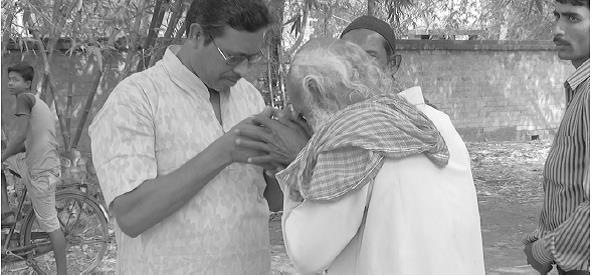
A common gesture of participants, greeting each other on Ursh festival
Large-scale of Devastation on October 2016
As already mentioned on October 29th 2016 there has been systematic attack on three Sufi centers of the village. The team has collected several narratives on that day. In the following section the event is presented after a careful analysis of the narratives. The following is a combination of the direct narratives along with somewhat detailed summary of the phenomenon.
It appears that a statement made by Hira Pir alias Nurul Amin Sekh on October 29, 2016 triggered this mass and organised a large scale violence against Sufi followers and centers. Nurul Amin Sekh is the Khadem or Pir of Qadiriyia Malamotiya Tartusia Tariqa at Dakhinpara of Nazirpur. In the first session of our fact-finding, AAMRA took part in a group discussion with Pirponthis of similar tariqa at a Khanqah of Teghori village. It was Qadiriyia Malamotiya Tartusia Tariqa at Paschimpara of said Teghori village where Janer Ali was the Khadem. Though in their application to the administration they are mentioned as Imams not Khadems. In this interactive phase Akbar Ali Sekh, Secretary of Baul Fakir Sangha accompanied us. Here is our interactive narrative at Teghori.
AAMRA: Please narrate us what happened on that day?
Pirpanthis in a Group Disussion [PP in GD]: People belonging to Qadiriyia Order met in a Ursh festival at Nazirpur where in a discussion local Khadem, Nurul Amin Sekh said that Rabindranath Tagore, Nazrul Islam and Mother Teresa, because of their honesty and dedication can be entitled for Jannat [heaven]. In response to such a statement local Shariat followers forcefully took Nurul Amin Sekh, Gulam Murtaza and other prominent faces of Sufi tariqas to the local Mosque. The shariat followers under the leadership of people like Raibul Islam and supported by the Imams of all local Mosques took the initiative of such attack on the Pirpanthis.
AAMRA: What was the nature of attack?
PP in GD: They harassed the pirpanthi (Sufi followers) and destroyed two adjascent Khanqah Sharifs and tried to vandalise this Khanqah Sharif as well [the very place where we were having the discussion that was Qadiriyia Malamotiya Tartusia Tariqa at Paschimpara of Teghori.]
They declared the Pirpanthis as of no longer having Muslim identities and those they were required to perform Qualma again to regain their religious identity.
AAMRA: What did you do afterwards?
PP in GD: Since the local police did not take our matters seriously, we thought of going to the president of Baul Fakir Sangha, Mr. Shaktinath Jha. We needed some organisational base and support. Mr. Jha asked us to send a letter to the local police.
We were not entertained and were told repeatedly by the local police to follow the directives of the Shariatis because they were numerically strong, to put it in their words “they are the 95% of the population and you should be able to stay with them peacefully!”
AAMRA: Did you try to access the local administration like Subdivisional Officer and the like?
PP in GD: Yes, when the local police station refused to lodge the complaint, we went to the Subdivional Officer (SDO) Berhampore, and also to the local Block Development Officer.
AAMRA: Did they take any initiative?
PP in GD: No, nothing so far from Government side.
AAMRA: What did they say?
Abdul Mannan: We went to the Police station together. The Officer in Charge [daroga] refused to take the complaint. I am saying this on record that Prasanta Daroga clearly said that “you belong to the 5% of the population and 95% of the people are against you. What makes you think that police will take action against the 95% of the people? You people must be able to accept whatever they say. ”
There was a person named Manik, who came here to enquire what happened, Hafez Nur Alam on behalf of Shariatis stopped him and locked him up. I called him up over phone and he confirmed that he was being locked up by Hafez. I directly called up Shaktinath Jha [the president of Baul Fakir Sangha/Association] and reported the entire event. Shaktinath babu called up the police station and it appeared that the Officer-in-Charge was his student. Meanwhile sensing the potential problem of administrative intervention Hafez released Manik and Manik directly came to the police station. So, when Shaktinath Jha called the Officer-in-Charge he was already at the police station. In consequence Shaktinath babu could not pressurise on police about their inaction.
Akbar Ali Sekh, Secretary of Baul Fakir Sangha, reflects on steps which they have taken. He says that:
We, on behalf of Baul Fakir Sangha, informed the whole issue to Association for Protection of Democratic Rights (APDR), the civil rights organization of West Bengal. Very recently in a magazine named as Bodhodoy, APDR has published an article based on what we have reported. We have take up the issue of attack on Pirpanthis here at our 34th Annual Conference held at Beldanga, Murshidabad.
AAMRA: Since, there is no initiative from Government; does it mean the atrocity on Pirpanthis is still continuing?
PP in GD: yes, it is.
Akbar Ali Sekh and others continued:
On the 3rd April 2017, one of the Pirpanthi followers, Mr. Jeher Seikh’s father, Fajlul Sekh was died. After death, local Mosque did not allow the family to organise the ritual procession, i.e. Namaz e Janaza. The Shariati’s has even tried to create hindrance in the performance of Burial process. Moreover, he has been harassed and tortured physically and mentally. Jeher Seikh has lodged a complaint to the Rejinagar Police Station.
AAMRA towards Akbar Ali Sekh: As we are being aware of the fact that, incidents such as this one is happening at different places of West Bengal? As we know about the continued attacks against Baul and Fakirs in West Bengal and Bangladesh. Do you find any difference between those events and this one?
Akbar Ali Sekh in the Group Discussion: It is important to understand that Pirpanthis and Baul-Fakirs have different sets of explanation on mainstream religious and allied texts. Piponthis practice Namaz but they have a different explanation behind such acts and actions. Some of them go to the local Mosque for performing Namaz, but all of them have respects and used to follow Pir. They give priority to Human. In the Darbar, women have an easy passage and entry. But you know that women entry is restricted in the Mosques. Shariyati Islamist wants uniformity in understanding and explanation of the religious texts and practices. They want from us to follow their explanations of Quran and to obey Fatwas. They don’t want any deviance from what they think is right.
Actually if you see history, attack on Bartaman panthi [another term of Pirponthi and which includes all the sects and variations which does not conform the orthodox Hinduism and Islam] is nothing new. There have always been attacks on people who think that there needs to be an integration and exchange of different faiths. I have seen that people who are practicing differently and showing their difference prominently has been targeted often. Here lies the difference. But understandably here the Pirpanthis do not display much prominent difference from the Shariatis.
One of the Pirponthis: We used to go the Mosque to perform Namaz rituals. In fact there has not been much prominent division between the two until recent time.
Akbar Ali Sekh continues:
Yes, this kind of attack on Pirpanthis is something new. I have seen this kind of attack on Pirpanthis here. I have seen attacks on Bauls and Fakirs, but not on Pirpanthis. You know, that there are reports of killing of Priests because of the failure to read Qalma, we have organised rallies involving many of the Bartaman Panthi to demonstrate how heinous crime it was to kill people in the name of Shariati Islam. What I feel is that this attack on Pirpanthis is an extension of such attacks on Hindus at Bangaladesh. This is very shameful, that even in a country like India; people are not allowed to practice their own faith and religion. We will take you and show you the places where such incidents have taken place.
AAMRA: We understand that Shariatis have their own claim over Quran. They argue that touching your head on Mazar, celebrating with Music and Dance is against Islam. While it is also clear that Pirpanthis or Sufis like Chistia, Naqsbandi, Qalandaria, Qaderiya understands reaching God is important no matter what medium one chooses. However, the local police and administration claims that Pirponthis represent only 5% of the population, is it a fact?
Akbar Ali Sekh along with others: First of all, we have to understand that Pirponthis are not atheist, they do believe in Quran, but they have a different set of understanding about Quran. While Baul and Fakirs do not believe in anything other than human beings. They did not perform Namaz, did not go to Mosque or temple. So, there is a fundamental difference between the two. [Perhaps this is why the attack on them becomes extremely important to study, they represent just one variety of Islam and they are not against the Islam per se] Now the issue of five percent is not an absolute and true estimate of the fact. These five percentages represent people who are taking up the challenge to reveal their Pirponthi identity openly, but there are hundreds of families who believe in Pirs but do not reveal such belief system out of fear. In my knowledge there are four different types of explanations of Quran: Shariat, Marfat, Haquiqat, Tariqat. Now there would definitely be different explanations but Quran does not allow anyone to kill or attack on others. Those who claim themselves as Shariyatis, even they are not allowed to attack others. What type of Quran do they follow?
PP in GD: You know here at Paschimpara of Teghori the Shariyatis could not destroy our Khanqua Sharif. Do you know why? Because, we people are able to fight them togetherly, because we resist.
AAMRA: How many families are here protecting Khanqua Sharif?
PP in GD: Here we are about fifty families protecting this Darbar.
AAMRA: How many families are sympathetic towards you?
PP in GD: There are many. You wouldn’t believe all of them are afraid of Shariyatis and hence couldn’t come out openly. Moreover the Pirponthis are not located in clusters and it becomes really difficult to defend when you don’t stay together.
Abdul Mannan: The Shariyati hooligan advanceed towards our Darbar by throwing bombs after demolishing consecutive three Darbars. We were prepared, we resisted. They had to go back from last end of Paschimpara.
AAMRA: Is your resistence was with weaponry?
Abdul Mannan: We are united, our united force forced them to withdraw their plan to demolish our Darbar.
AAMRA: Has there been any visit by organisations like APDR or something like that?
PP in GD: No, they didn’t come to the place but some person from APDR called up the police and a professor from Beldanga College took us to the Superintendent of Police (SP).
AAMRA: What about the local political parties, do they extend support?
Jaher Seikh: They are also of the same opinion. Since we are only 5% of the population, they will not do anything against the Shariyatis. So far we understand Indian National Congress (or the Congress party) has supported them. Trinamool Congress is silent.
AAMRA: Did you try to contact Trinamool people then?
PP in GD: No, we do not want to bring politics in our religious practices. We wanted to get help from the administration and not from the politics. Why should we go to the political leaders, we haven’t done anything wrong. We will practice our religion, our belief system in our own way; we don’t want politics to get any space within it.
Discussion with Nur Amin Seikh, Pir
After our intensive discussion with several victims of October 29, 2016 attack, we went to visit at the Khanqua Sharifs which experienced such attacks. We had an opportunity to talk to the local Pir, Nur Amin Seikh, Khadem of the afore-said Khanqua Sharif of Qadiriyia Malamotiya Tartusia Tariqa at Dakhinpara of Nazirpur.
“This Darbar was built up in 1997. At present I am the Khalifa/Pir of this Darbar. On that day (29 October, 2016) I was sitting on my Darbar and discussing about religious practices to be followed. But unexpectedly a few local boys entered in to my place. Among them Rezaul Mir, Rabiul Islam and others said that Rabindranath Tagore will go to hell. I reacted and said that ‘are you secretary of the heaven, who will decide that?’ I also said that ‘Mother Teresa, who helped so many poor and diseased persons, do you think she will go to hell as well?’ I didn’t say anything else. However, the Imam of the local Mosque called me up and instructed all the villagers to come and attend. Almost 2000 people gathered there. While we were having a discussion and I was giving logic to support my contention, the mob actually started attacking on my Darbar and destroyed a significant part of the construction.
You wouldn’t believe what I experienced in Mosque. I remembered revolutionary poet, Qazi Najrul Islam’s statement that Temples and Mosques are places where devils live, I actually experienced it. They started using slangs which I cannot utter here. They asked me to donate the space for Darbar to them so that they can transform it into Maqtab. I said the land is not in my name, how can I give it? They asked me sign in a non-Judicial Stamp paper declaring that I was giving it to them. I tried to convince them that this does not belong to me; it is registered in the name of my guru. They displayed aggression and I was afraid of being beaten up by them. Then I thought since, this is not in my name even if I sign, it won’t have any legal value. Therefore, I signed it.
We informed police. They came to the village but couldn’t enter because of the pressure of the local Shariyati followers who did not allow police to enter. They even vandalised the police car and the police went away. But later on, police tried to resolve the existing conflict by calling representatives from Mosque and me. Again heated debate started and police said that since we are smaller in number, we should follow their religious practices. I said West Bengal has more than 8 crores of population, but why did you keep the photos of Quazi Najrul and Rabindranath Tagore in the police station? Don’t you think that they are different and that is why you are keeping their photographs? But debate continued. There were about five Moulabis against whom I had to argue on my own. Officer-in-Charge (OC) made a quick fix solution by asking both of us not to go the Darbar. However, on the next day they tried to forcefully acquire the space, which was resisted by my followers together. We lodged a complaint to the Police Station and this time they took the FIR, and called both the parties to go for a mutual agreement. However, the Mosque committee a day before that meeting forcefully take out a written declaration that no atrocities had been done against me and that we already have made a mutual agreement. On the day of meeting, they placed that piece of paper in front of OC, and OC ordered us to avoid going to the Darga.
AAMRA: What is the present situation now?
Seikh: Things have never been peaceful. After a few months there was a big Ursh being organised at my Guru’s place. Many of my disciples from this village organised an orchestra party and the situation within the village again became tensed. Murabbi, Maulna from the big Mosque of the village came to me and told me that since OC has already told villagers not to go to the Darbar, why are you breaking the instruction? I replied that, that place belongs to us and I will go there. Police cannot declare curfew that can only be done by the court. The Mosque committee wanted to convert that place to a place for reading Quran, Maqtab, an idea which I refused to comply. I said I won’t give this place for doing that, this village has enough place for organising such activities. I think they decided that since I was not agreeing with them they should take some radical step.
AAMRA: What radical step did they take?
They brought people from the neighbouring ten villages by using loudspeaker which they usually use during Azan. In consequence thousands of villagers gathered near my house. However, the mob also had some reasonable persons as well, who actually stopped anything adverse from happening. One of the local school teachers Mr. Anwar Ali Islam gave a short speech against the Shariat panthi people and asked them to stop cornering and attacking the Pirpanthis. It is primarily his initiative which actually stopped the large scale conflict; otherwise, I don’t know what could have happened.
After a week or so, two local boys named Qashem and Abdul was asked me not to attend the Darbar. You know, this sort of everyday threat is there. It is adversely affecting our everyday life, but you know despite of such hurdles I have started to build up the Darbar once again, and I sit there at least once every day.
However, although we could record most of the details of the incident which is still continuing but increasingly there was a strong resistance from the womenfolk of the family. They requested us to stop enquiring anything further. They strongly contended that since we have come and visited his place from outside, there may be some adverse consequence afterwards. Pir’s wife told,
“We have no allegation against anybody; you people please leave this place. We want a peaceful life and we want to live a normal life. Please do not telecast him in television channels… life is more important than ideology and faith.”
“Nobody came to rescue us. We have nothing to do, but to surrender under Shariyati system. My son is a BSF personnel; my daughter in law is here. We declare that from now we have full belief in Shariyati brand of Islam. Please take our statement as our stand.”
We confirmed her that we are not from any Electronis media, so this interview has no chance to be telecasted. The anxiety she showed was the reality of the area. We got experience concerning the post-traumatic phase of a tortured family.
A converse with Golam Mortaza
We entered at Golam Mortaza’s residence which is located at the western side of the village Nazirpur. Golam Mortaza had two sons and a daughter. His daughter is married and both of sons are involved in small business activities. Golam Mortaza used to work as a government employee with the department of Irrigation and Water Resources. He identifies himself as an outsider to the village because he has migrated from his native land to this place about 35 years ago. This village is his wife’s native place and close to his workplace. Moreover, because of the proximity of schools where he could send his sons and daughter, he thought of settling here. Hence, because of the convenience he is settled here permanently.
AAMRA: Tell us about your native place, how was it?
Golam Mortaza (GM): It is known as Mia Nabagram, under Shaktipur Gram Panchayat. There was only one High school, i.e., Shaktipur School, so I thought that it is a better option to settle.
AAMRA: When did you become a pir?
G Mortaza: Actually, I had no inclination towards the pirpanthi practices or for that matter religion itself, but during my service life I came in contact with my guru, Abdul Satta Kazi Ratul Mulayak in the year 1977. He had a great influence on me. And I was almost dragged to his philosophy and I become his disciple. I have spent seven long years with him. I have observed him closely and have learned a lot. His Tariqua is known as Qadiriya Tariqua.
AAMRA: How do you practice Qadiriya Tariqua?
G Mortaza: We meet for a mehfil on every Thurshday night, which is called as Jumma Raat. Here we discuss religion and philosophy of life together. We consider this mehfil to be extremely sacred. We also do Egaro Sharifer mehfil on each month of the lunar calender. It is done to memorise the departure of our guru from earth to heaven. It is important to remember that we follow Islam prescriptions completely and do these kinds of practices in addition to this. When these performances are taken place I become mast, i.e. engulfed with the thought and practices. So at one point of time my Guru gave me the leadership for this Najirpur region.
AAMRA: How did you continue the practice?
G Mortaza: We have established Khanqua Sharif where such mehfils are taken place. We have one Khanqua sharif here and also one at Andul Beria. But I somewhere in between my life there was a disagreement with my guru regarding some of my family issue and I stepped back. However, I could never forget the meaning and the philosophy of my Guru. Since, I have studied a lot; I could actually understand the meaning of the practices and mantras.
For several reasons, my wife and my children did not want me to continue as a local leader of the Qadiriya Sharif. But eventually, they stopped supporting me. Earlier they were disciple as well. However, since they wanted me to leave this Tariqua, I tried to pursue my wife. I told her that I am not going to live forever; I am going to retire soon. I won’t stop you from whatever you do and please let me continue whatever pleases me. There will be no shortage of love and compassion in our relationship.
Although, she disagreed but later she realised that if she continues to prevent me I might become Deewana (here abnormal) and later on she gave me permission to continue the practices.
AAMRA: What do you think that instigated conflict between you and the Shariatis?
G Mortaza: I think they were jealous of my popularity and the popularity of Qadiriya Tariqa. I used to explain the Kanoon [law] of this Tariqa to the people and several people used to listen to me which instigated a fear among the Shariatis and Ulama2 – well it is my interpretation. Ulama who got their schooling from Berily they believe in Qaderia Tariqua but those who have taken their training from Deoband, they do not believe in this Tariqua. Although I have seen in Delhi, there is no conflict between these two. In Delhi India’s largest Marquaz, i.e. Nizam Marquaz is located near the Hazrat Nizammudin Awliya’s Mazar Mubaraq. People from different faith buy rose from the shops falling within the periphery of Awliya’s Mazar Mubaraq and offer the flower to Nizam Marquaz. People perform Kawwali, and there is no such conflict.
AAMRA: How did the conflict started here?
G Mortaza: It was started by my own relative. My wife’s brother’s son got training from Muradabad. When he came back he started saying that we must change our practices here and follow what he has learned. He didn’t talk to me directly, but tried to influence my wife – his father’s sister.
AAMRA: How did your wife react?
G Mortaza: My wife told him that he practices his religion meticulously and I have never seen him doing anything wrong. Why should there be any conflict between your way and his way?
AAMRA: What happened then?
G Mortaza: Then he went on and talked to each of the Imams of eight Mosques of this village. The Nizamuddin Saheb, who is the chief Imam of the big Mosque, gathered villagers. They are actually Jamat3 followers and they do not tolerate any other form of Islamic practices than what they believe is right.
Along with a few others, under the leadership of Mosque committee Noor Alam Hafez, my brother-in-law’s son and Rezaul Karim came to our home and warned me to discontinue my Tariqua in the Khanqa Sharif. The team also included Noor Hossein Chowdhury, who is the secretary of the Mosque. They asked me to practice namaz according to Jamati tradition and abandon Qadiriya Tariqua.
AAMRA: Did you protest?
G Mortaza: Yes, I said that am I doing anything wrong here and am I harming anyone, then why should I discontinue this tradition?
They dragged me to the Mosque used abusive language and threatened to beat me up. They declared us as Kafer. Whatever, we do is Bedad, offering flower to the Mazar is bedad and that we are no longer Muslims. They also said that since Islamic rule does not support these kinds of activities, we won’t allow you do these things here. They order me to perform Qalma, used fatwa as kafer and tried to exclude us from the community and our identity.
AAMRA: How many people were there?
G Mortaza: I guess there were about five hundred people inside the Mosque. They did not allow me to speak. They never wanted any conversation but to make us follow their instructions only.
AAMRA: Did anyone protest?
G Mortaza: Excepting one gentleman from this locality, Kabol Mirza, none of the villagers could say anything against them. No one protested. He used to work at Calcutta Tram Corporation. He is an old person. He tried to say something but no one listened to him. They have also declared that in my Darbar they will organise Arabic teaching classes and will train people according to the dictate of Quran. They forcefully took written document from me that I am giving away that part of the land to Mosque committee. I tried to say that this land is not in my name, but they refused to listen to it. Despite all pressure I said no, then they started physically assaulting me in front of the whole village. So, I signed.
AAMRA: What did you say to them?
G Mortaza: I said that Indian constitution has a word called secularism. So far I understand it gives permission to each of its citizen to practice their own faith and belief system. Even, before completing this statement they pushed me and ordered the angry mob to vandalise the Khanqa Sharif. So, they came and broke my Khanqua Sharif.
While this conversation was going on, Golam Mortaza’s wife and daughter was present and they repeatedly asked him to conclude and not to take more names who have contributed to the atrocities. They frequently looked outside, if anyone form village has listened the statement of Golam Mortaza.
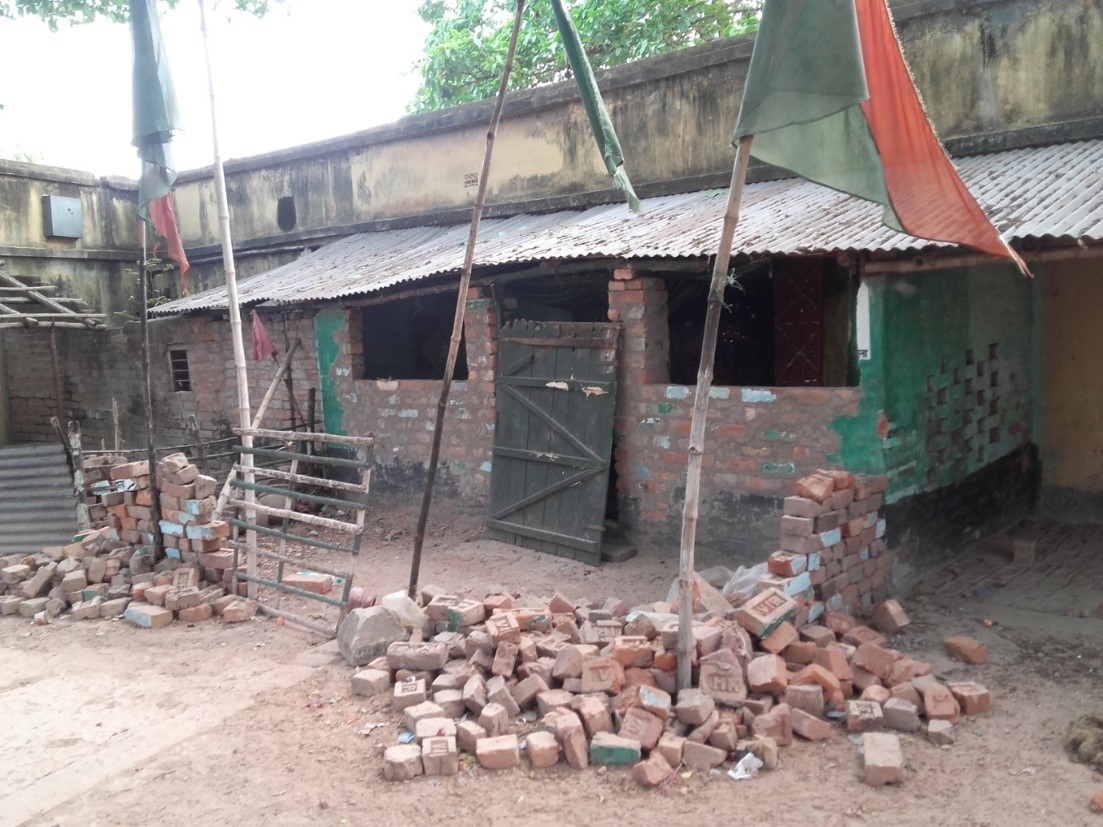
Demolished Khanqua Sharif of Chistya order as we saw in April 2017
Testimony of Jeher Sekh
It is a testimony of Shariyati brutality. Jeher Sekh (Village-Najirpur, Baganpara, Police Station-Rejinagar) lost his father Fojlul Haque at 2pm of 3rd April, 2017. While performing the last ritual , Namaj-e Janaja of his father, Jeher was prohibited. The persons were Nur Alom Mondal, Qasem Sekh, Mintu Sekh, Nur Husen Mondal and others. Jeher told us that his ‘crime’ was that he is a follower of Sufism. They kicked out Jeher and other Sufi follower from the Kabarstan. Jeher made complain to the Rejinagar Police Station, but no person was arrested.
Interaction with Khadim of destroyed Khanqa Sharif:
First time we met Sudon Mollah, the priest or Khadim of Darbar of Soleman Baba in April and he immediately invited us to attend an Ursh celebration which is going on for last 47 years. He follows Chishtiya Tariqa and argues that people widely participate in their activities every year. In April 2017 he narrates:
“It’s not that there was no counter force from the Shariati followers, but they have never been able to defeat us in logic. It is also important to note that earlier the number of rational and sensible people were more than today. The problem is we have hundreds of supporters but none of them are aggressive like the Shariati people. They like and support our way of extending help to people. These supporters are not only from the Muslim communities but also from the Hindus as well. You know our ‘Guru’ has established his ‘Ashram’ in Phultala, Char Krishnabati, in Hooghly district. You wouldn’t believe that the place is occupied by Hindus only. People across caste, creed and religion go there and perform.”
AAMRA: Please tell us what happened on the day they have destroyed your Khanqa Sharif?
Sudon Mollah (SM): The day they have destroyed our Khanqa Sharif, they did not engage with any conversation with us. They did not give us a chance to debate rationally. I was not present at that time. I usually spend my evening at western side of the village at the Darbar (Qadiriyia Malamotiya Tartusia Tariqa at Paschimpara of Teghori) which you have visited today. Though we are the followers of Chishtiya Tariqa, but we all Sufi followers used to go each other Darbars, we have no restriction.
AAMRA: Did you see who destroyed your Darbar?
SM: No, I didn’t but some of those who were involved have told me that they did not want to destroy it, but eventually it went off their control.
AAMRA: did you inform administration?
SM: No, we haven’t! But we have supported those who have lodged FIR against them.
AAMRA: Is it because you are afraid?
SM: No, we are waiting for a response to earlier complaints made against them by others. And in those complaints there is a mention of our issues as well.
AAMRA: Why there are two adjacent Darbars?
SM: Here are Qadiriya Tariqua and Chishtiya Tariqa. These two are different and so two different Darbars can co-exist. We all follow Sufism.
Ursh visit and reflections on polarization :
Ursh festival took place on 23rd April 2017 at the already destroyed Khanqa Sharif of Soleman Baba. We, on behalf of AAMRA went to make a visit to find out a wide scale participation in the Ursh. Most eye-catching among the participants are the children of the village. We had several conversations with the participants and we find it difficult to differentiate between a Pirpanthi and Shariati followers. In a group discussion (see figure 4) we had the following conversation.
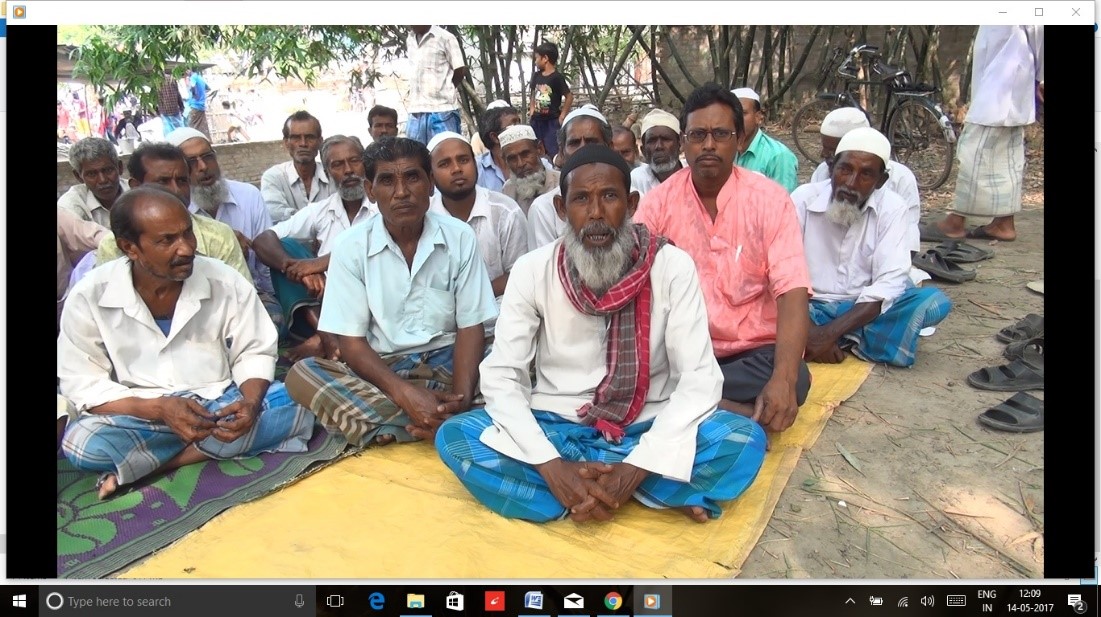
Group discussion on violence during Ursh festival of Chishtiya Tariqa
Participant 1: We did not have any conflicting relationship with anyone within the village, but for last few years there has been a development of constant threat from the Shariati followers lead by the Imams of our local mosque. It was not like this but we really do not know why they are trying to exclude us as different from Muslims.
FFT: What was your response?
Participant 2: Our guru, our learning do not guide us to instigate violence on anyone. We cannot adopt violent means over them. But we told them firmly that we will continue to do what we are doing for years. We have also told them that we will celebrate Ursh, cook khichdi (a special dish made from rice, dal and vegetables) on the day we have been doing this for last several decades. If you say this is adamancy then yes we are adamant.
Women in polaraisation :
During Ursh visit, we have also tried to talk to several villagers who participate in activities organised by the local Pirs as well as Mosque. One of the women responded in the following way, we are not disclosing her name:
The woman: “We organise Majlish, Egaro Sharif, and also go to Masjid for prayer. We also donate for every event organised by the Masjid committee. It is not that we hate them, or we avoid them, these two practices can co-exist, we never found anything bad in such a co-existence. We are doing the both since our childhood. No one ever said anything, but now for last six months or so, they are creating havoc mess with whoever is following pirpanthi practices in the village.
AAMRA: What did they say?
The Woman: We have to leave Pir. Pir will not exist! Our guru has died. We respect his Mazar. We do chaddar charano and decorate the space with flower. We perform Majlish. Their point is, these are against Shariat rule and in order to remain Muslim, we need to follow Shariati rules.
AAMRA: Who are they?
The woman: He is the head of the Masjid (Masjid er morol). The problem is recently the head of the Masjid is changed. He is from outside. He instructs and there are three Maulabis in the village who try to execute whatever the head of the Masjid instructs. They say that Quran does not allow such practices. But you know it is very easy to interpret Quran according to one’s one wish. We do not understand Quran that is why we needed Pir to show us the right path. And believe me; we did no harm to anyone. Our Pir always instructed us to prioritise humanity and not to indulge in conflicts.
AAMRA: What do you perform additional as followers of Pir?
The woman: After we become followers of Pir, we can go the Mazar, pray, and can talk to outsiders. Like you can see I am talking in front of a camera.
Akbar Ali Sekh (supplementing): It is more about freedom for woman. A pirpanthi woman would never stay inside.
The woman: Yes, that is a big change in our life. But you know the way we walk, we talk outside of our village is different. Here we still follow certain unsaid traditions so that our behavior does not create any odd situation. But that is also their problem. They recommend women to stay under Parda or veil.
Akbar Ali Sekh: You know that the way we came here, talking and recording women’s voices is unthinkable for the Shariatis. They will not take these things lightly. According to them this is against Islam.
A few reflections in this context from our experience are important. When we had intensive discussion with Nur Amin Seikh and Golam Mortaza in their houses, both of them gave importance of their wife and daughters in making their life choices and decisions. In fact, since there was several incidents of violence, the family members of both Nur Amin Seikh and Golam Mortaza was in a kind fear psychosis. In each of the two cases we have seen that their wives and daughters came and tried to resist our intrusion asking us to stop recording. Although, when we talked to them individually and explained our purpose they agreed to continue the interview session. However, such incidents portray importance of women and extent of their voices.
Interaction with Imam of Local Mosque
We asked him how you can ignore the fact that Prophet himself visited his mother's grave and wept. Then Imam became nervous and replied us after few seconds that he cannot do anything wrong. We told him that Prophet said, 'I sought my Lord's permission to seek pardon for her (mother), but he did not permit me. I then requested to visit her grave and he permitted me to visit her grave.' It was also from Sahih Muslim, we told.
In the next session Imam told us that here almost 95 percent of Muslim is Shariyati followers, so the presence and practice of Pirpanth may ruin social balance. We asked him how he can calculate this percentage, where a large section of people participated in the Ursh on 23 April, 2017. He replied that it is their ignorance and old habit who participated. Participation in Ursh, giving chadar to any Mazar is un-Islamic, he told. 'Then how can you explain the ignorance of Sheikh Hasina, Prime Minister of Bangladesh who recently visited Ajmer Sharif and Raja Parvez Ashraf, Prime Minister of Pakistan who visited the same shrine on the year 2013?'-we asked. Surprisingly Imam refused to give any comment now and suddenly showed his eagerness to stop the discussion. When we asked him how he can avoid conflict here in this village, he responded that he was not involved in any clash, so can't able to give any solution.
Imam is a person of good manners, we gave him thanks for affording some times for us.
Latest development
Up to first week of August, 2017 as we got information from villagers, the situation was distressing. Tension erupted after visit of journalist, activists in May, 2017. Delayed news coverage made further tension; Shariyatis threatened Pirponthis for disclosing those torturous incidents to the ‘outsiders’. But no further incident like demolition was occurred. The social concord among all sects of Islam was butchered. The Pirponthis now perform their Namaj at Darbar, as they are disqualified by the Shariyatis from Muslimhood. For them door of Mosques is closed. Darbar or Khanqah is usually a place for religious discussion and Dhikr. No Namaj or Salat (prayer in Arabic) was performed there. Dhikr is basically a Quranic word, commanding ‘remembrance of God’, and an act of devotion during and after salat or prayer. Each Sufi orders has a dhikr of its own, constructed by its founder. Here in these three adjoining villages among four Khanqahs two are from Chistiya order and remaining two are form Qaderiya order. October, 2016 catastrophe changed the role of Khaqahs, by including Namaj within its periphery. We know that here Khaqah was traditionally open for women. Now for post-October phase inclusion of Namaj in Khaqah also gave them (women) chance to perform Namaj in Khanqah.
Summary of issues :
It is important to note that certain issues of which are ingrained with this sort of violence.
- Consolidation of ideal Muslim prototype: While the Pirpanthis have traditionally been associated with a variety of different ways to reach to the Gods, it is often seen as anti-Islam and hence in a process the definition of Islam according to Shariatis becomes further narrow down. It is therefore, made to look like a fight between ideologies. But attack is one-sided.
- Attack on people who occupy a middle range:
As the issue is addressed by Akbar Ali Sekh who has quite a long experience of observing such attacks by fundamentalists on Baul and Fakirs, this attack is a new phenomenon. Baul Fakirs are seen as deviant as they are declared atheists (primarily against Vedic and Quranic notions), but Pirpanthis do follow almost every Islamic activities, and yet they are targeted. The nature of such attacks confirms the above mentioned fact that this is indeed an attack to consolidate identity and difference. Moreover, in Foucauldian term this is actually an attempt to disciplining people according to the ideologies of the dominant group.
- Abrupt social exclusion and violence: The event also indicates a systematic exercise of violence over Pirpanthis which range from verbal abuse to physical torture. It is often made legitimised in the name of anti-Islam practices. Social exclusionary mechanism is often infiltrated with humiliation (as manifested in redoing Qalma), annihilation (as manifested in attempted forceful occupancy on Khanqua Sharifs) and violence (as manifested in brining mass to the Mosque and targeting individuals especially the aged Pirs). Later on the continuation of Fatwa with labeling as Kafer, Murtad and anti-Islam is actively perpetuated. There are certain other prescriptions as well. For example Pirpanthis are told that there will be no space in the local graveyard for the bodies of the Pirpanthis to be buried. They will not allow any death procession – Namaz e Janaza.
- Freedom of women:
It is important to note that the relative freedom enjoyed by women folk among the Pir followers is vital. This is not only an important issue of the Muslim society but also reflects the nature of challenge that these people face from the Shariat followers.
- Sudden polarisation:
Although, it is not evident in the discussions which has been taken place, but in stray conversations with villagers and Pirpanthis we came to know that villagers who actually participated in the destructive act, are also the one who participate in Ursh festivals and the like. Therefore, as we have come to know that even during the mass and organised violence a few voices, like that of a school teacher and the ex Tram Company employee indicate an otherwise peaceful ambiance of the three villages. Moreover, as repeatedly been told, there is a conscious attempt to build up terror among the common villagers which is resulting in complete dismantling of Pirpanthis.
- Issues of organisation and lack of organisation: While numerical strength is seen as one of the determining factors, there is also an important factor related to the organisation and lack of it. Mosque, along with its organisational base has been able to mobilise people effectively – a skill which Pirpanthis lack. In response to such and organised attack, Pirpanthis too have tried to get affiliation to the Baul Fakir organisation which primarily protects the rights of Bauls and Fakirs. Therefore, such affiliation indicates the fact that Pirpanthis do recognise the need for being organised.
- Administrative ignorance: The politico-administrative linkage is extremely important to understand the role of the state in addressing these issues. Although, we could directly talk to the police and other administrative players, but repeated mention about reluctance from the administrative part is indicative of indirect promotion of such incidents. No attempt is made to secure the interest of the numerically weaker section of these villages.
Therefore, it is extremely important to address such less known and often unreported issues of violence between different religious practices which is increasing in recent times. It is quite clear, from the three cases that the consolidation of religious identities coupling with the numerical strength is systematically disrupting the communal harmony of the country in recent times. West Bengal is no exception to this depressing story. While, there is a lack of political will to contend such problems, it is high time that civil society brings these issues into the positive discourse of the civil society movements. To avoid it by saying that these are the internal problems of ‘their’ religion is a dangerous concept. This motive will rebirth and continue violence and polarization.
On behalf of AAMRA an e-mail has been sent to the office of District Magistrate of Murshidabad and Block Development Officers of Beldanga II Block, reporting a brief of what we have found and seeking response from their part in the light of the Article 15 and 25 of the Constitution of India which preserves the right of people to practice religion freely. AAMRA also urged to maintain peace and normalcy. However, till date AAMRA did not get any response from their end.
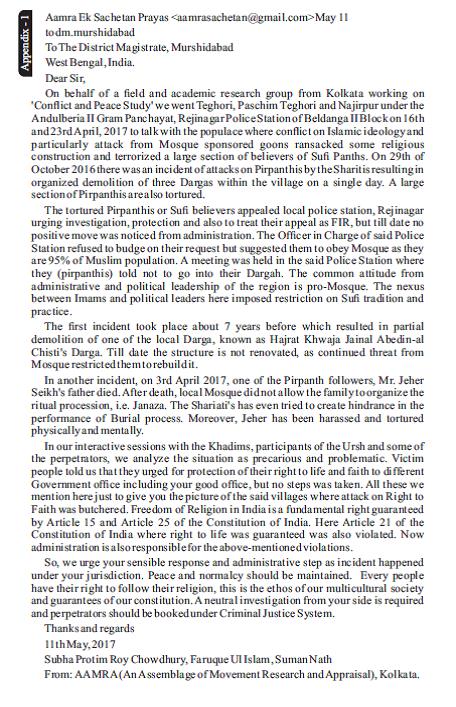
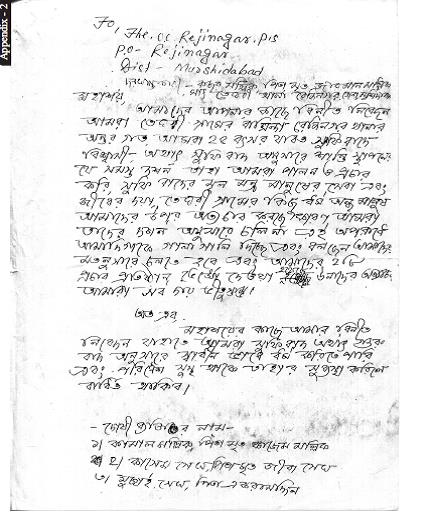
Appendix-1: email from AAMRA to The District Magistrate, Murshidabad
Appendix-2:The complaint letter Lodged to the Rejinagar police station by local Pirpanthi folks.
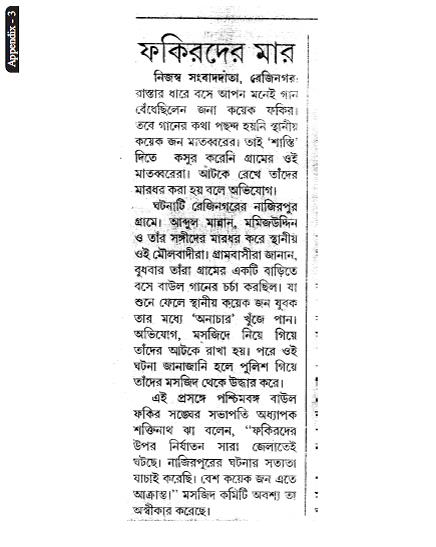
A paper cutting of Report published in Bengali daily news magazine on physical harassment of Fakirs of Najirpur village, Rejinagar.
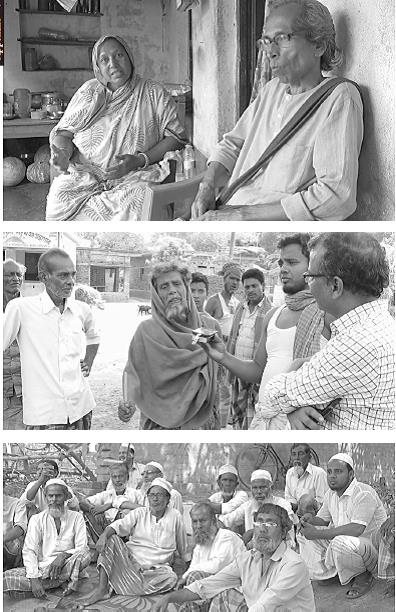
Few pictures : AAMRA fact finding team Interacting with Akbar Ali Sekh & other folks of Rejinagar
Notes-
- Wahabism or Wahhabiya- An ultra-conservative, puritanical Muslim movement adhering to the Hanabaite law, although it regards itself as ghair muqallidin, non-adherent to parties, but defending truth. It arose in Najd in the Arabian Peninsula during the 18th century. Its founder, Muhammad Ibn Abd Al-Wahhib (1703-87) found a champion in the tribal leader Muhammad Ibn Saud of the Dariya region, and from then on the Soudis became the main supporters of that movement. They believe that the Muslims have abandoned their faith in one God (tawhid) and have distorted Islam through innovations (bida) which run counter to pure Islam: ‘All objects of worship other than Allah are false, and all who worship such are deserving of death’ (Abd Al-Wahhib). The Wahhabis accept only the Quran and the authentic Hadith and reject 1400 years of development and interpretation in Islamic theology and mysticism. They oppose any veneration of saints and tombs, prohibit the decoration of Mosques, ban luxury and forbid any importation of kafir culture in their society. Furthermore, all Muslims who do not accept their creed are regarded as heretics, particularly the Shias, who are considered as archenemies of Islam.
During the 19th century, the Wahhabis in alliance with the Saud family began to expand territorially, and to threaten the interest of the Ottoman Empire. In 1802 they captured Karbala, and in 1803 Mecca. Thrown back by a long campaign, they were not politically strong until Abd Al-Aziz Al Saud captured Riyadh and established a new kingdom. The Hejaz was taken, but attempts to expand northward were blocked. Within the new kingdom of Saudi Arabia, the Wahhabis became dominant in conservative control, introducing mutawwiun, ‘enforce of obedience’, a kind of private religious police, monitoring not only public but also private conformity to Islam
- Tariqa- Originally a way of classifying the rules and methods by which a mystical approach to God might be sustained; it became a term for the different Sufi systems themselves, along with their rules and rituals.
- Qadiriya- A Sufi order (tariqa) founded in the 12th century by Abdal al-Qadir al-Jili, who was revered as a teacher and also a worker of miracles. Given the Sufi tendency to see the manifestation of being in the particulars of creation, but especially in Sufi adepts, it is not surprising that al-Jili was regarded as Lord of creation after and under God, and reverenced as ch. His tomb in Bagdad is a place of Pilgrimage. The order makes use of music and dance, particularly to encourage trance states. It is widespread from Morocco to India.
- Chishtiya- Min al Din Muhammad Chisti (AH 537-633) was an Indian, who mediated an important order (tariqa), Chistiya into India. He was much influenced by Abd al-Qadir-who, as a traditionalist, once said, ‘my foot is on the head of every holy man.’ Chisti emphasized fear of hell-fire as an important constraint in religious life, but he also encouraged music and chant since ‘song is the support and the sustenance of the soul’. The Chistiya, the sufi movement derived from him continues to make music central. It developed the qawwali (singers) whose songs of love and devotion to Allah are a feature of holidays and festivals. He died at Ajmer, and his tomb is celebrated place of pilgrimage. The heads of the Indian Sub-continent used to make trip to Ajmer Sharif as it gathers one of the highest numbers of pilgrims in India from different faith.
- Khanqah means assembly place of Derwishes. Derwishes is a member of Muslim religious fraternity, the groups gather around a particular Sufi teacher. Each group has its own chain of succession (silsila, which every member must know) through which the esoteric teaching and practice have been transmitted. For that reason particular ritual of a group is as important as salat or prayer. The practices and teachings of the many groups are too varied.
- Shariyati means Quranic and Hadith-centric brand of Islam, where any other form is restricted.

আমরা: এক সচেতন প্রয়াস
AAMRA is an amalgamation of multidisciplinary team of researchers and activists erstwhile worked as an assemblage of movement, research and activism. Popular abbreviation of AAMRA is, An Assemblage of Movement Research and Appraisal.-
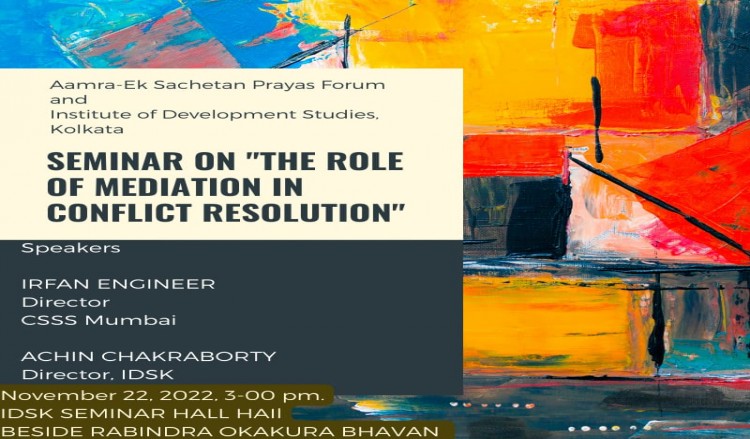
Seminar on Role of the Mediation in Conflict Resolution, IDSK Hall, Kolkata, 22 November, 2022
This seminar explores how a conflict area complicates... -
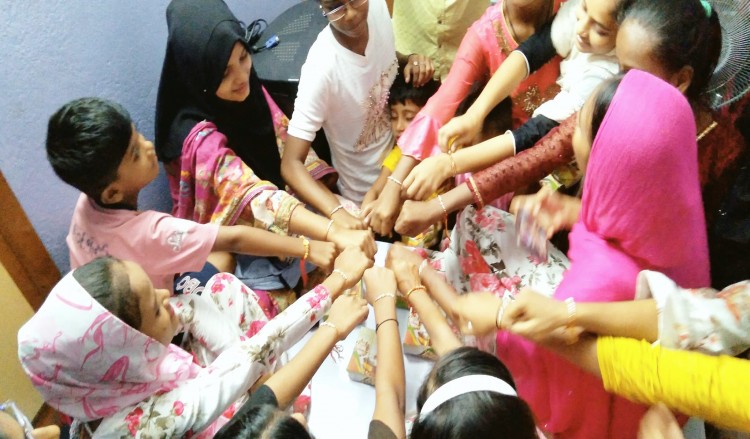
'ये बंधन देश का' Festival of Rakhshabandhan, Bengal Peace Centre, Bhatpara, North 24 Paraganas; 18 August, 2024
Bengal Peace Centre from the beginning is working on... -
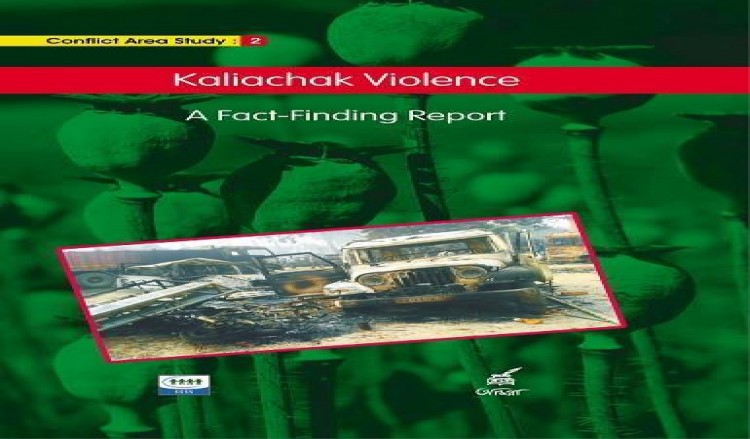
KALIACHAK FACT-FINDING REPORT
‘Your daily life is your temple and your religion’... -
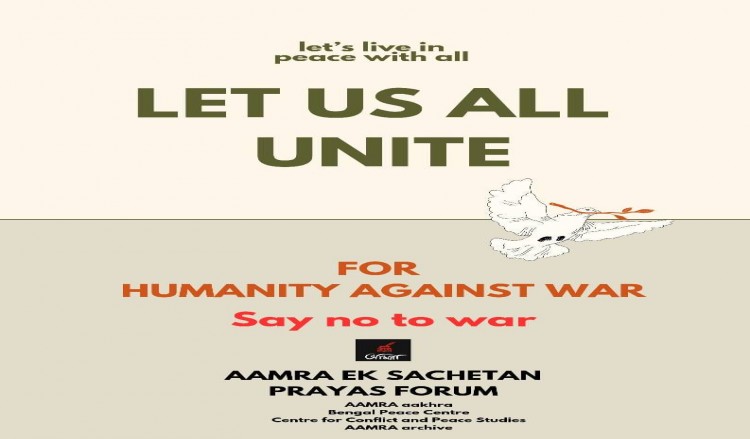
Say no to war, let peace be our only path
We strongly oppose this war. We unequivocally state...
